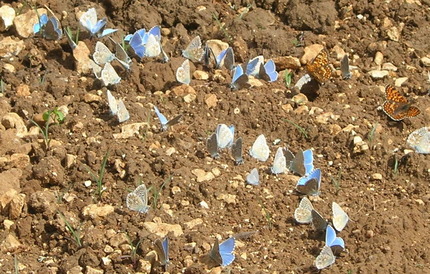Dordogne butterflies
This web page is to illustrate some of the range of butterflies we see on our holidays in the Dordogne in May, based at Castang. Which is the odd one out above of these four across the top? See bottom of page for answer.

Above: male Adonis blues taking minerals, with two knapweed fritillaries. Adonis blue is one of many species that is tricky to get close to.
Right: sooty copper. The male lives up to its name, but the upperside of this female is similar to a small copper. |
It isn't all of them by a long way (to see full lists, look in our holiday reports), and we don't see all species every year on our holiday, usually around the second week of May. Some butterflies have quite short period on the wing and we may see a lot of one butterfly during one holiday and none in another, linked to the weather that year.
Scarce swallowtail. An distinctive species, with its zebra-like stripes, and seen every year. Like a lot of wildlife, the name comes from a UK perspective. Flies with wings in a V-shape, like a marsh harrier!
Black-veined white, here on an ox-eye daisy in Castang's meadow, with a fabulous pattern recalling a leaded window. Extinct in the UK for reasons that remain unclear.
Fritillaries can be confusing. These the species we encounter most.
Meadow fritillary, a fairly uniform looking species, and often the commonest 'frit'.
Click on the picture for a bigger picture of this butterfly. |
Glanville fritillary Look for the row of spots in the hind wing's last-but-one row of cells. This one is perched on the rim of bug box. More on Glanville fritillaries here. |
Knapweed fritillary With caterpillar, below. The imago* shows contrasting colours ... |
... though the marsh fritillary, which we usually find by Roque St Christophe, is brighter and more contrasting still. * imago - the fully developed adult stage of an insect. |
Violet or weaver's fritillary: the former name is from the larval food plant. A faded individual. |
Skippers can look like moths, especially when they land with wings folded. Note the knobbed antennae, like all butterflies ... and also burnet moths, see right ...
Above left: grizzled skipper. Above, middle and right: more common in our area is Oberthur's grizzled skipper, less grizzled looking, and with a reddish-brown underside hindwing.
Moths add further interest. Left: burnet companion moth, often in the same areas as burnet moths. Middle: giant peacock moth (at rest, rather than a day-flying species). Right: cream-spot tiger moth, the odd one out - a moth and the rest are butterflies.
Chris Durdin, January 2012
Dordogne orchids . . . . . . Dordogne bugs . . . . . . . . . Back to nature notes

